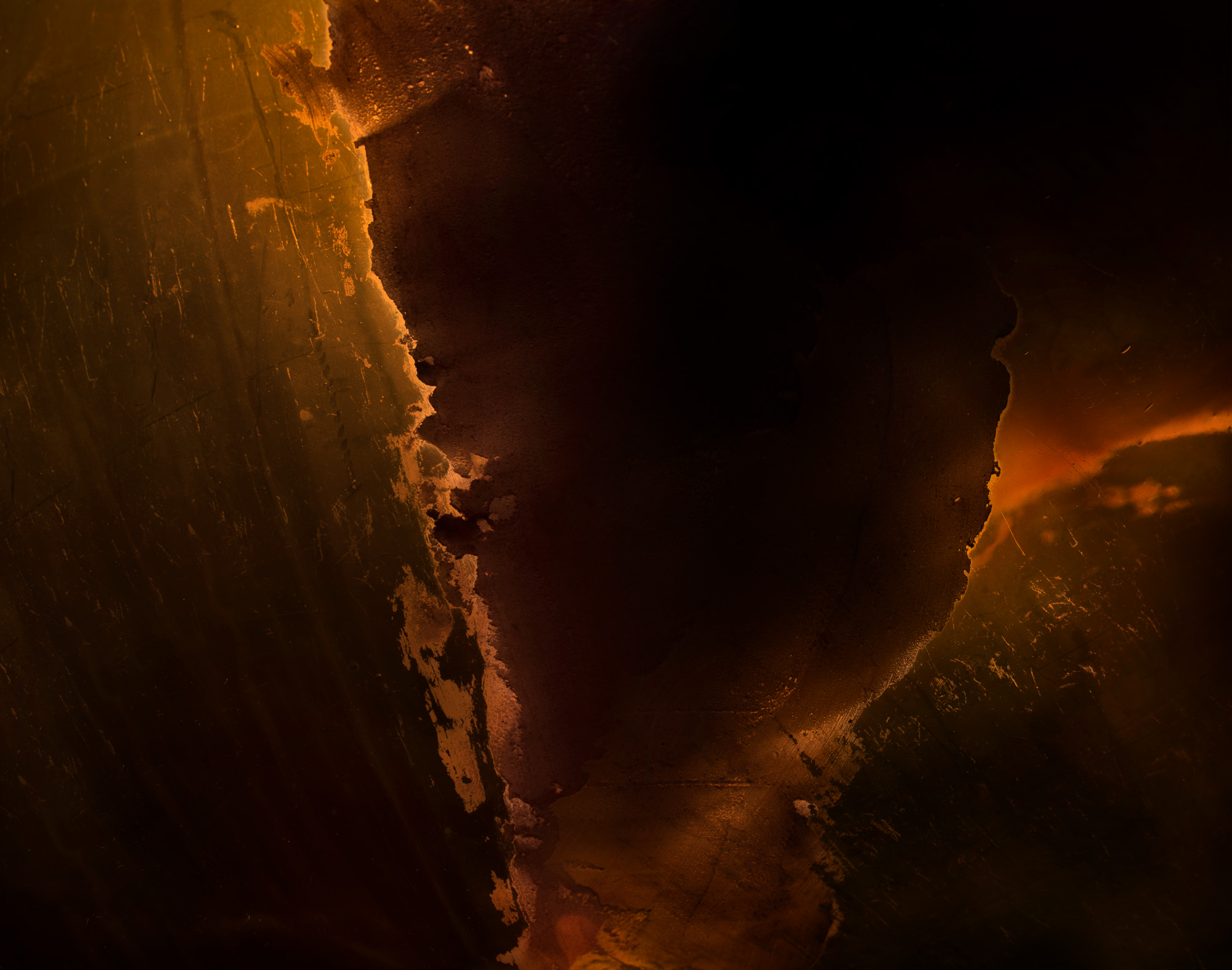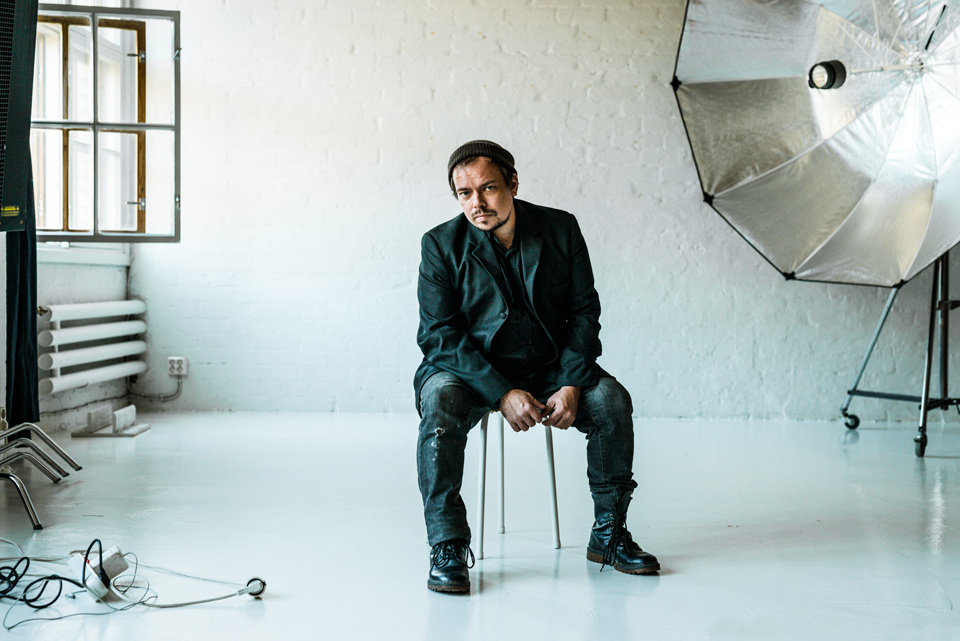Keskustelu Perttu Saksa & Mika Hannula
Maps of Essence
Perttu Saksa tunnetaan lumoavista, synkistä valokuvateoksistaan, jotka yhdistävät dokumentaarista ja lavastettua kuvastoa. Saksan taiteellinen tuotanto koostuu vahvoista temaattisista kokonaisuuksista, jotka muistuttavat antropologista tai filosofis-eettistä tutkimusta voimakkaan visuaalisen taiteen muodossa. Saksa tutkii taiteessaan ihmisen ja luonnon välisiä rajoja sekä suhdettamme ympäristöön ja eläimiin.
Perttu Saksa (s.1977) on opiskellut kuvataideakatemiassa Suomessa ja Islannissa. Tällä hetkellä hän suorittaa taiteen tohtorin opintoja Aalto-yliopistossa. Saksan töitä on esitetty useissa museoissa ja gallerioissa Suomessa ja Euroopassa, muun muassa Stadt Galleri Kielissä, Felleshus Berlinissä, Suomen Valokuvataiteen Museossa, Helsingin Kaupunginmuseossa ja Kiasmassa. Saksa on palkittu Fotofinlandialla vuonna 2014, vuonna 2017 Saksa oli ehdolla Ars Fennica -palkinnon saajaksi. Hänen teoksiaan löytyy useista julkisista kokoelmista, kuten Kiasman, The Polaroid Collectionin, Helsingin Kaupunginmuseon ja EMMAn kokoelmista. Saksan poeettista dokumenttia Eläimen kuva (2018) on esitetty kuluvan vuoden aikana lukuisissa eri yhteyksissä, muun muassa Doc Point -festivaaleilla. Vuonna 2018 Saksan ehdotus voitti presidentti Mauno Koiviston hautamuistomerkkikilpailun, monumentti nimeltään Kartta paljastetaan Koiviston syntymäpäivänä, 25.11.2018.
Mika Hannula: Näyttelyn valokuvat muodostavat sarjan, jolla on oma selkeä historiansa. Mihin valokuvat paikantuvat – tai toista kautta kerien: mikä on niiden paikka, paikallisuus, ja mitä on näyttelyn nimen taustalla?
Perttu Saksa: Matkustin neljä vuotta sitten Beninissä ja Togossa ja kiinnitin huomiota teiden varsilla olleisiin lukemattomiin bensakojuihin, joissa myytiin Kpayoa, Nigeriassa toimivilta monikansallisilta öljy-yhtiöiltä varastetusta öljystä tislattua huonolaatuista bensaa. Kyse on varsin laajamittaisesta toiminnasta, jonka vaikutus on niin suuri, että ilman sitä paikallinen infrastruktuuri lamaantuisi. Gungbenkielinen sana Kpayo tarkoittaa huonolaatuista ja ylijäämää, piraattituotetta. Bensiini on ranskaksi, Beninin virallisella kielellä, essence. Englanniksi essence viittaa toki myös sanaleikkinä olemiseen, laatuun ja luonteeseen.
Kiinnostuin konkreettisuudesta, jolla ihmisen toimintaan vaikuttava ja sitä perustava rakenteellinen asia, öljy ja energia, paikallistui hyvin fyysisenä ja kirjaimellisesti käsin kosketeltavana elementtinä ihmisen tasolla. Aineen valta ihmisen toimintaan kuvastuu oikeastaan vasta fyysisyyden kautta, energian muuttuessa näkyväksi arjessa läsnä olevaksi elementiksi. Näyttelyn nimi tulee karttoja muistuttavista bensakanistereiden pinnoista, joita olen kuvannut valaisemalla kanistereita taustapuolelta. Kellanpunainen valo siivilöityy mutaisen ja kolhuisen astian sisällön läpi. Bensakanistereiden pinnoissa ja niiden sisällä sakkautuva neste muodostaa kuvia bensan – energian olomuodoista.
MH: Päästään olemuksellisuuteen, asioiden ja täällä olemisen ytimeen. Näyttelyn kuvat asettuvat varsin abstraktin mutta maisemallisen ilmeen kautta ihan konkreettiseen tilanteeseen: käsien pesuun bensalla teoksessa Maps of Essence #17. Miten teokset ovat muokkautuneet? Lähditkö liikkeelle abstraktista vai konkretiasta – vai onko niillä mitään eroa?
PS: Tämä sarja on kulkenut ja kiteytynyt bensan salakuljetuksen dokumentaarisesta kuvaamisesta, varsin konkreettisesta lähtöpisteestä siis, abstrakteihin ”bensakarttoihin”. Kuvasin aihetta ensin laajalti saadakseni muodostettua siitä paremman kokonaiskuvan itselleni ja varmuutta siihen, että kulkisin editoidessani oikeaan suuntaan. Tiivistyksen ja kiteytyksen kautta jäljellä on enää vain aiheen ydin, ”puhdas” energia ja toiminta aivan sen ympärillä.
Bensan myynti- ja tankkauspulloista koostuvat asetelmat toimivat avaimina siihen, mistä oikeastaan on kyse – pienistä mittayksiköistä ja kierrättämisestä, joka toistuu Afrikan mantereen markkinoille tehtyjen alkoholipullojen vähintäänkin omituisessa kolonialistisessa nimeämisessä, ”Black Magic London Dry Gin” ja niin edelleen, joka on paikallisella tasolla piraattisisältönsä kautta kääntynyt vielä kerran ympäri. Kulttuuriset kiinnekohdat on kuitenkin lähes pyyhitty kuvasarjasta pois. En niinkään käsittele sitä, mitä tapahtuu Länsi-Afrikassa, vaan sitä, miten suhtaudumme energiaan ja mitä se on ihmisen näkökulmasta käsin. Käsienpesukuva, sehän on ainoa kuva, jossa ihminen on varsinaisesti läsnä ja jollakin tapaa rikkoo keskittymisen yksin tähän aiheeseen. Käsien yhteispesu bensalla – siinä on paljon ajatuksellisia tasoja ja se on eleenä brutaali ja sakraali samaan aikaan. Käsienpesulla ja juomapulloilla on selkeä sidos kehoon ja ruumiilliseen kuluttamiseen. Sekä pullot että käsienpesukuva toimivat jonkinlaisina avaimina tai lukuohjeina karttakuville ja auttavat muistuttamaan katsojaa mittasuhteista.
MH: Entä Maps of Essence #6 -teos, jossa näemme kanisterin, jota ei enää oikeastaan ole, vaan jonka tilalla on enemmän tyhjää, pois mennyttä – ja jonka muoto on suhteessa ihmispäähän. Mikä on tämän teoksen työprosessi ja taustatilanne?
PS: Kuvassa on yritys peittää bensaa paahtavalta ja kuumalta auringonvalolta sivelemällä tienvarressa kuumenevia bensapulloja ja kanistereita joka paikasta löytyvällä punaisella tomulla, joka sadekuurojen aikaan muuttaa tienvarret vellovaksi mutalikoksi. Olen valaissut bensan pullon sisällä, mutakuori peittää pullon ja bensan läpi siivilöityvän valon ja muodostaa kuvaan kallomaisen negatiivisen tilan. Tämä on sarjassa keskeinen kuva, jonka kautta päästään kiinni karttakuvien mittasuhteisiin ja siihen, mistä niissä on kyse. Öljystä on käytetty nimitystä ”musta aurinko”; sen sisältämä, maan sisään säilötty ikuinen ”negatiivinen valo”, energia, on ikään kuin auringonvalon vastakohta. Näissä pulloissa ja kanistereissa minua viehättää juurikin niiden suhde valoon, joka on tässä kuvassa ehkä konkreettisimmin läsnä.
MH: Teoksissa on erinomaisen vahvasti läsnä elon voiman ja olevaisen raihnaisuuden samanaikaisuus, vastakohtien vuoroveto, kuten myös vastakkaisuuksien kautta eteen ja taakse liikkuminen ja liikuttaminen, unohtamatta liikuttumista. Miten suoraan itse liität nämä teokset esimerkiksi länsimaiseen kristinuskon kuvastoon, vanitas-valaistukseen ja asetelmiin?
PS: Vanitas-asetelmissa on symbolisesti toistuvia elementtejä ja allegorisia viittauksia valtaan, elämän kiertokulkuun, syntymään ja kuolemaan ja niin edelleen. On kiinnostavaa, kuinka paljon samoja teemoja löytyy öljyn läsnäolon kautta pullokuvista. Halusin korostaa tätä, rakensin kuviin asetelmamaalauksellista hämärää valaisua ja hyvin vanitasmaisia, frontaaleja sommitelmia.
MH: Miten koet ja näet nämä uudet teokset jatkumossa esimerkiksi edelliseen gallerianäyttelyysi, Silence as a phrase Helsinki Contemporaryssa 2015?
PS: Edellisessä gallerianäyttelyssäni tarkastelin eläimen kuluttamista ja subjektin katoamista, elämän ja yksilön muuttumista materiaksi. Uudessa näyttelyssä on kyse samankaltaisesta liikkeestä, jossa objektin ja subjektin määritelmät häilyvät. Edellisen näyttelyn kautta syntyi kiinnostukseni materiaalien läsnäoloon ja kuluttamiseen, joka on noussut tämän näyttelyn keskeiseksi teemaksi. Viittasin myös aiemmin valolla ja asetelmallisuudella kristilliseen kuvastoon, joka toimii länsimaisen kuvanluennan ja historian kulmakivenä.
MH: Minkälaisesta materiasta tai materialismista tässä on kyse?
PS: Ihmisen toimintaa säätelevät valtavat rakenteet – öljy ja energia muodostuvat konkreettisiksi vasta käsin kosketeltavuuden sekä visualisoituvan laadun ja yksilöllisen luonteen kautta. Kpayo avautuu inhimillisen mittakaavan kautta tarkasteltavaksi, ja aineen merkityksellisyys herättää sitä materiana eloon. Tämä havainto muuttaa tapaa katsoa energiaa ja sen liikkumista maailmassa. Onko kyse kuolleesta materiasta, vai jostakin, jota ymmärtääksemme meidän tulisi myös laajentaa käsitystämme subjektin ja objektin, elävän ja kuolleen välillä?
MH: Miten toivorikasta tai toivotonta tämäntyyppisen, varsin suoraviivaisen olemuksellisuuden kohtaaminen on? Miten ristiriitaiseksi koet nämä tilanteet ja sen kaaren, josta työprosessi lähtee ja johon se päätyy?
PS: Mitä tieto(isuus) suhteestamme ympäristöön, suhteen tuhoisasta luonteesta tekee meille? Mitä teemme sillä tiedolla, pystymmekö käsittelemään sitä ja kohtaamaan omia puutteitamme? Nämä ovat kysymyksiä, jotka määrittävät sitä, keitä me olemme ja mitkä mahdollisuudet meillä on tulevaisuudessa. Itselleni konkreettinen havainto on ollut, kuinka fossiilinen energia työskentelee itse asiassa negatiivisesti, on lähtöasetelma elämää vastaan, tuhoaa sitä vaikka lähtökohtaisesti yritämme ajatella siitä päinvastaisesti. Tämä on aika lohduton näkymä. Palaan kysymykseesi edellisestä näyttelystä – Eläinkysymys liittyy olennaisesti myös tähän, pisteeseen, kyseenalaistaa ja määrittää uudelleen subjektin rajoja ja merkityksellisyyttä, ihmisen ja ihmisyyden hierarkioita.
MH: Näen kuitenkin nämä teokset erittäinkin voimakkaina ja avaavina, en epätoivoisina tai flegmaattisen luovuttaneina. En tiedä, sopiiko tähän sana tai käsite ”voimauttaminen”, mutta jotakin näyttelyn teosten kautta lähtee uudelle tasolle, uudelle merkityksen kierrokselle. Joten vaikea kysymys, mutta olennainen: teoksista välittyvä toivo, halu jatkaa, yrittää – mistä se tulee tai mihin se kiinnittyy?
PS: Maps of Essence kuvaa itseorganisoitumista ja globaalin talouden lomassa liikkumista tasolla, jossa on jotakin kekseliästä ja hyvin inhimillistä positiivisessa mielessä. Karttojen nimeämättömät paikat ovat kuin ”Terra Nullius” – Ei kenenkään maa – ja viittaavat uuden löytämiseen ja uusiin ratkaisuihin, sitä kautta myös toivoon. Toivon kääntöpuolena on passivoiva, pysähtynyt elementti; sokea usko siitä, että joku tulevaisuudessa ratkaisee (ilmasto-)ongelman sen käydessä esteeksi olemiselle. Kyse on kyvyistä ja kyvyttömyydestä suhteessa tähän havaintoon ja toki myös siitä, miten määritellä tulevaa ja kenen, elollisen vai elottoman, perspektiivistä käsin.
MH: Siirrytään kolmiulotteisiin teoksiin, näihin käärmemäisiin veistoksiin. Mikä on niiden syntyprosessi?
PS: Pronssiveistokset pohjautuvat valokuvaamiini python-käärmeisiin, jotka ovat länsi-afrikkalaisessa vodun-uskonnossa keskeisiä eläinhahmoja. Niitä näkee silloin tällöin myynnissä fetissimarkkinoilla tai uskonnollisissa tilaisuuksissa. Fetisseihin ladataan energiaa ja voimaa, joilla on kyky ohjata elämän kulkua. Bensaa ja öljyä voi hyvin ajatella myös uskonnollissävytteisenä voimana ja energiana.
Käärmeveistokset pohjautuvat Beninissä kuvaamiini valokuviin fetissimarkkinoiden käärmeistä. Koin jollakin intuitiivisella tasolla yhteyttä näiden energia-aiheiden välillä. Olet ehkä kuullut allegorisen kertomuksen maanviljelijästä, joka löytää lumesta käärmeen ja kantaa takkinsa sisällä lämpimään. Virottuaan käärme puree pelastajaansa, koska se on tarinan mukaan käärmeen luonto ja tilanne on käärmeeseen kajonneen viljelijän itse aiheuttama. Käärmeen osa on usein edustaa pimeyttä ja jonkinlaista synnynnäistä epäluotettavuutta. Eläimen esittäminen symbolina jollekin inhimilliselle ominaisuudelle on tapa, jolla taiteessa useimmiten eläimiä esitetään. Mielestäni sitä on nähty ihan riittävästi maailmassa. Eläin on eläin. Veistosten fyysisyys toimii tämän puolesta.
MH: Eli kolmiulotteisissa teoksissa tapahtuu vielä yksi etäännyttävä liike, joka välttää kuvittamisen sekä toden ja todellisen umpikujat?
PS: Käärmeissä on kokonaan toinen, fiktiivinen taso, jonka lähestyminen valokuvan tekemisen kautta vaatisi määrätietoisempaa etäännyttämistä, kuin mitä olisin valmis tekemään. Pidän siitä, että valokuvani tasapainoilevat dokumentaarisen ja fiktion välillä. Pronssiveistoksista puuttuu valokuvan indeksinen suhde todellisuuteen ja siihen, mitä on ollut.
MH: Entä miten koet veistosten suhteen valokuviin?
PS: Käärmeiden ja valokuvien välille syntyy vuorovaikutus galleriatilassa. Valokuvien ja veistosten välillä on tila, joka laajentaa molempien sisältöä. Materiaalien merkitys ja energia ovat läsnä veistoksissa konkreettisesti. Siirtymä tähän on alkanut muutama vuosi sitten, vanhojen valokuvamenetelmien kautta, kun kuvan tekemisen fyysiset materiaalit, erityisesti hopeanitraatti, alkoi korostua merkityksellisenä osana esittämiäni teoksia. Esittämisen ja materian merkityssuhteet kiinnostavat minua yleensäkin. Pronssikäärmeissä on läsnä valtava määrä energiaa ja jälkiä siitä, niin valutyön vaatiman energian ja metallien kuin (hopeanitraatti)patinoinnissa käytettyjen prosessienkin kautta. Tämä on läsnä myös Maps of Essence -sarjan valokuvissa, joiden materiaaleissa konkretisoituu öljyn läsnäolo Diasec-vedostuksessa käytettävien akryyli- ja silikonimateriaalien kautta.
MH: Onko näissä teoksissa läsnä tai tapahtumaisillaan myös jonkinasteinen vuoroveto digitaalisen ja analogisen kuvan ja materiaalin kokemuksellisuuden välillä – ja välityksellä?
PS: Valokuva itsessään on materiaalisesti aika tyhjä ja olematon. Valokuva on ilmaisuvoimaltaan syönyt itse itseään loppuun digitalisoituneen kuvan ja kuvapaljouden myötä. En usko valokuvan poliittiseen ilmaisuvoimaan samalla tavoin, kuin mitä se on ollut vielä lähihistoriassa ennen siirtymää digitaaliseen kuvien massaan. Valokuvasta kuvan tekemisen poliittinen ulottuvuus on lähes hävinnyt, kuva on syönyt itse itsensä. Veistoksissa siitä on ehkä jotakin jäljellä.
Kaikilla materiaaleilla ja mediumeilla on toki läsnäolonsa, mutta ne ovat luonteeltaan hyvin erilaisia. Arkaaisiin materiaaleihin, niin kuvanveiston kuin valokuvauksenkin kohdalla, sisältyy materiaalista, fyysistä läsnäoloa, materiaalin aikaa ja historiaa, mitä ei ole yhtä vahvasti läsnä digitaalisen monistettavuuden kautta, oli sitten kyse valokuvasta tai vaikkapa 3D-tulosteesta.
MH: Vielä veistoksista, ja hyvin erityisestä hankkeesta, joka paljastetaan vuoden lopulla – presidentti Mauno Koiviston hautamuistomerkki, jonka suunnittelukilpailun voitit ja jota parhaillaan toteutat. Jo teoksen nimi, Kartta, yhdistää sen gallerianäyttelyyn. Minkälaisesta kartasta on kyse – suhteessa menneeseen ja/tai tulevaan?
PS: Haluan korostaa katsojan aktiivista osaa suhteessa ajanjaksoon ja historiaan teoksen ympärillä. Hautamonumentti tarjoaa mahdollisuuden ja sitoo paikkaan, jossa teos on. Hautausmaa ja Koiviston muistomerkki on hyvin erityinen aihe. Minulle se on tekijänä jopa henkilökohtainen aihe. Koivisto oli lapsuuteni presidentti ja ensimmäinen presidentti Kekkosen jälkeen, joka kuljetti Suomen demokratiaan ja osaksi Eurooppaa. Hautamuistomerkki on kiinnekohta suhteessa aikaan ja paikkaan – kartta tai kompassi kokonaisuuteen, kollektiiviseen ja yksityiseen muistikuvaan. Toivon mukaan ei sementoiden sitä, vaan pitäen historiaa aktiivisena osana nykypäivää ja tulevaa.
Monumentissa kartta ilmentyy kiven murtumia yhdistävänä kultauksena, joka mukailee japanilaista keramiikan korjaustekniikkaa, jossa hajonneen esineen murtumia ja lohkeamia korostettiin kultaamalla rikkoutuneet palaset yhteen. Historia piirtyy aktiivisena osana rikkoutumien ja kulumien korostamisen kautta. Kartta on kuin peili, jonka kautta tarkastella omaa suhdetta ja paikkaa historiassa, se tarjoaa aikaa tulla tietoiseksi siitä. Hautamonumentin ja gallerianäyttelyn kohdalla on kyse hyvin eri asioista toki, mutta samankaltaisista havainnon ja muistamisen prosesseista. Maps of Essence -sarjan kohdalla kyse on suhteessa energiaan, sen tuottamiseen ja kuluttamiseen – energian olemukseen.


Share this exhibition